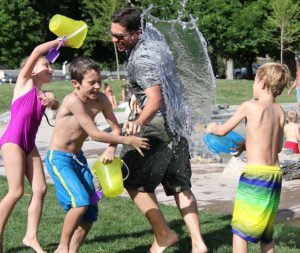
- Keep your children out of the sun during the hours of peak UV rays, between10 a.m. and 4 p.m.
- Babies under six months of age should be kept out of direct sunlight.
- Use a sunscreen made for children with a sun protection factor (SPF) of at least 30, and apply it 15 to 30 minutes before going into the sun. No sunscreen is truly waterproof. It must be applied every one to two hours, particularly if your child spends a lot of time in the water.
- The signs of a sunburn usually appear six to twelve hours after exposure. If your child’s burn is simply warm, painful and red, it can be treated at home by applying cool compresses to the burned areas or bathing the child in cool water. You also can give acetaminophen to help relieve any pain. A sunburn may also cause blistering, fever, chills, headache, and a general feeling of illness.
- Your child doesn’t have to be seriously burned in order to be harmed by the sun’s rays. The effects of sun exposure are cumulative – even moderate exposure during childhood can contribute to wrinkling, freckling and skin cancer later in life.
- If fever, chills, headache, a general feeling of illness, or blisters accompany the sunburn, call your pediatrician. Severe sunburn must be treated like any other serious burn; if the burn is extensive, hospitalization may be required. Blisters can easily become infected, requiring treatment with antibiotics. Severe sunburn may also lead to heatstroke, which is characterized by dehydration and fainting.
- Don’t assume the sun is only dangerous when it’s shining. It’s not the visible light rays but rather the invisible, ultraviolet rays that are most harmful. It’s possible to be exposed to more UV rays on foggy or hazy days. Exposure is also greater at higher altitudes. And remember that UV and UVB rays reflect off sand, water and snow.
Dr. Bertolino wishes you and your kids a marvelous summer – stay sun-smart, happy and safe!



